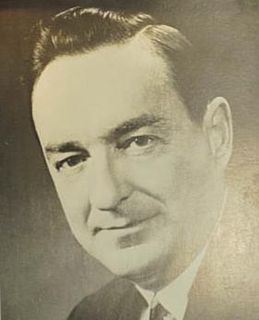
The United States presidential election of 1900 was the 29th quadrennial presidential election, held on Tuesday, November 6, 1900. In a re-match of the 1896 race, Republican President William McKinley defeated his Democratic challenger, William Jennings Bryan. McKinley's victory made him the first president to win consecutive re-election since Ulysses S. Grant had accomplished the same feat in 1872.
The 1964 National Convention of the Republican Party of the United States took place in the Cow Palace, Daly City, California, on July 13 to July 16, 1964. Before 1964, there had been only one national Republican convention on the West Coast, the 1956 Republican National Convention, which also took place in the Cow Palace. Many believed that a convention at San Francisco indicated the rising power of the Republican party in the west.
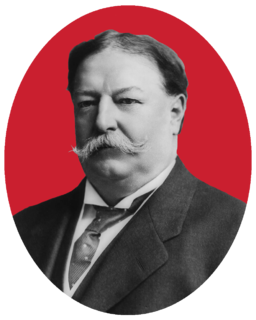
The 1908 Republican National Convention was held in Chicago Coliseum, Chicago, Illinois on June 16 to June 19, 1908. It convened to nominate a successor to the popular GOP President, Theodore Roosevelt and his Vice President, Charles W. Fairbanks.

The 1948 Republican National Convention was held at the Municipal Auditorium, in Philadelphia, Pennsylvania, from June 21 to 25, 1948.
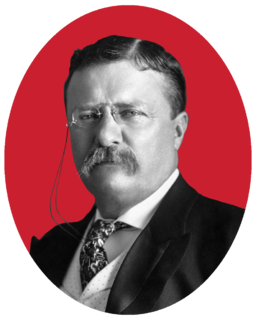
The 1904 National Convention of the Republican Party of the United States was held in the Chicago Coliseum, Chicago, Cook County, Illinois, on June 21 to June 23, 1904.
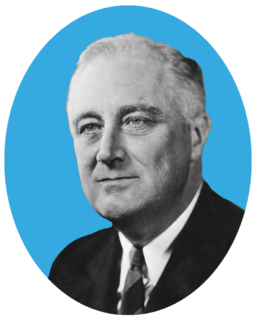
The 1940 Democratic National Convention was held at the Chicago Stadium in Chicago, Illinois from July 15 to July 18, 1940. The convention resulted in the nomination of President Franklin D. Roosevelt for an unprecedented third term. Secretary of Agriculture Henry A. Wallace from Iowa was nominated for Vice President.

The 1964 United States presidential election in Rhode Island took place on November 3, 1964, as part of the 1964 United States presidential election, which was held throughout all 50 states and D.C. Voters chose four representatives, or electors to the Electoral College, who voted for president and vice president.

The 1832 United States presidential election in Pennsylvania took place between November 2 and December 5, 1832, as part of the 1832 United States presidential election. Voters chose 30 representatives, or electors to the Electoral College, who voted for President and Vice President.

The 1908 United States presidential election in New York took place on November 3, 1908. All 46 contemporary states were part of the 1908 United States presidential election. New York voters chose 39 electors to the Electoral College, which selected the president and vice president.

The 1896 United States presidential election in New York took place on November 3, 1896. All contemporary 45 states were part of the 1896 United States presidential election. New York voters chose 36 electors to the Electoral College, which selected the president and vice president.

The 1900 United States elections elected the 57th United States Congress. The election was held during the Fourth Party System. Republicans retained control of the Presidency and both houses of Congress, while third parties suffered defeats.
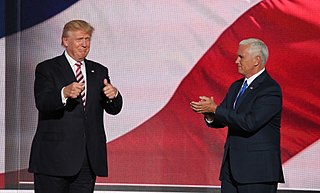
This article lists potential candidates for the Republican nomination for Vice President of the United States in the 2016 United States presidential election. Businessman Donald Trump of New York, the 2016 Republican nominee for President of the United States, considered several prominent Republicans and other individuals before selecting Governor Mike Pence of Indiana as his running mate on July 15, 2016. Pence formally won the vice presidential nomination on July 19, 2016, at the 2016 Republican National Convention. As the Trump-Pence ticket won the 2016 presidential election, Pence became Vice President of the United States on January 20, 2017.

This article lists potential candidates for the Democratic nomination for Vice President of the United States in the 2016 election. Former Secretary of State Hillary Clinton, the 2016 Democratic nominee for President of the United States, chose Senator Tim Kaine of Virginia as her running mate. The formal nomination took place at the 2016 Democratic National Convention. The Clinton-Kaine ticket lost the 2016 presidential election to the Republican Trump-Pence ticket, and Kaine returned to the Senate following the campaign.

This article lists those who were potential candidates for the Republican nomination for Vice President of the United States in the 1980 election. Former California Governor Ronald Reagan won the 1980 Republican nomination for President of the United States, and chose former Texas Representative George H. W. Bush as his running mate. Reagan had considered naming former president Gerald Ford as his running mate, but after Ford and Reagan were unable to agree to be on the same ticket, Reagan turned to Bush, his primary rival for the 1980 Republican nomination. Though Bush had criticized Reagan's policies, Reagan chose Bush to help unify the party, and Bush agreed to be on the ticket and to support Reagan's platform. The Reagan-Bush ticket defeated the incumbent Democratic Carter-Mondale ticket, and in 1984 won re-election defeating the Mondale-Ferraro ticket. Bush was later elected president in his own right in 1988.

This article lists those who were potential candidates for the Republican nomination for Vice President of the United States in the 1952 election. After defeating Ohio Senator Robert A. Taft for the Republican presidential nomination at the 1952 Republican National Convention, General Dwight D. Eisenhower needed to choose a running mate. Taft recommended Illinois Senator Everett Dirksen, but Eisenhower rejected the suggestion. Eisenhower and his advisers put together a list of prominent Republicans who were acceptable to both the conservative Taft and liberal Dewey wings of the party, anti-Communist, talented at campaigning, relatively young, and who contributed to Eisenhower's nomination victory. After conferring with Republican Party leaders, Eisenhower decided to ask California Senator Richard Nixon to be his running mate; Nixon accepted the offer. Nixon had carefully campaigned for the post of vice president since meeting Eisenhower in 1951, and Nixon helped deliver the California delegation to Eisenhower in the presidential ballot. The Republican convention ratified Eisenhower's choice of Nixon. Months after the convention, Eisenhower considered asking Nixon to step down as running mate due to controversy surrounding campaign expenses, but Nixon rallied public opinion with his Checkers speech and remained on the ticket. The Eisenhower-Nixon ticket won the 1952 election, as well as the 1956 election, defeating the Stevenson-Sparkman and Stevenson-Kefauver tickets, respectively.

The 1964 United States presidential election in Hawaii took place on November 7, 1964. All 50 states and the District of Columbia, were part of the 1964 United States presidential election. Hawaii voters chose 4 electors to the Electoral College, which selected the president and vice president of the United States.

The 1964 United States presidential election in Connecticut took place on November 3, 1964, as part of the 1964 United States presidential election, which was held throughout all fifty states and D.C. Voters chose eight representatives, or electors to the Electoral College, who voted for president and vice president.

The 1896 United States presidential election in Wyoming took place on November 3, 1896, as part of the 1896 United States presidential election. Wyoming voters chose three representatives, or electors, to the Electoral College, who voted for president and vice president.


